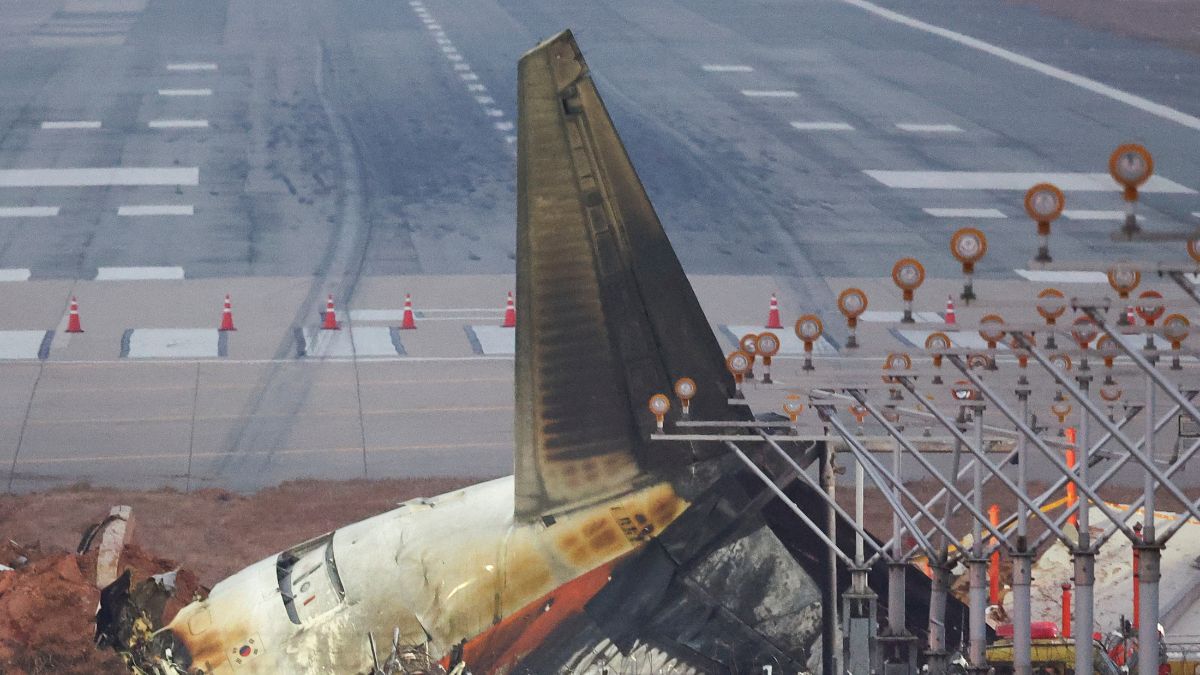South Korea witnessed its worst aviation disaster in decades on Sunday (December 29) after a Jeju Air plane crashed at Muan International Airport in the country’s south. The tragic mishap killed all 175 passengers and four of the six crew, with only two members surviving.
The Jeju Air Boeing 737-800 belly-landed and skidded off a runway at the airport, hit a concrete fence and erupted in a fireball. Reports say the two survivors were pulled alive from the tail section of the plane.
Sunday’s plane crash in South Korea came within days of another aviation disaster. On December 25, an Azerbaijan Airlines plane crash-landed near Aktau in Kazakhstan, killing 38 of the 67 on board. The aircraft was allegedly hit by Russian air defence by mistake. It is believed that most of the survivors were seated in the plane’s rear.
As these back-to-back aviation disasters raise concerns about plane safety, we take a look at whether there are the safest seats on a plane in the event of a mishap.
How safe is air travel?
Air travel is remarkably safe as compared to other forms of transport. In fact, 2023 was the second safest year for airline safety as per all the incidents recorded by the Aviation Safety Network database, reported Forbes.
According to this database, of the 35 million (3.5 crore) flights worldwide, there were 1,213 serious incidents, 134 accidents, five fatal incidents, and 105 casualties.
Data from the International Air Transport Association, which represents the global airline industry, showed that there was one plane accident that led to deaths, out of the 37.7 million (3.77 crore) flights last year.
Plane crashes are extremely rare and air travel continues to be the safest mode of transportation.
Is the rear seat safest?
A common factor from the Azerbaijan plane crash and South Korea n flight accident is that the survivors were seated in the rear part of the aircraft.
Studies have shown that it is generally safer in the middle or at the rear of a plane. However, most flyers do not prefer travelling in the back of the aircraft as it is too close to the lavatory and has too much commotion due to the galley.
A 2015 analysis by the Time magazine of 35 years of the United States aviation regulator Federal Aviation Administration (FAA) data of plane crashes up to that year found that statistically fewer people seated in the rear of the aircraft died in a mishap.
As per the analysis, seats in the back third of the aircraft had a 32 per cent fatality rate, compared to 39 per cent in the middle third and 38 per cent in the front third.
To be more precise, Time magazine found that the middle seats in the rear of the aircraft were statistically the safest, with a 28 per cent fatality rate. On the other hand, seats on the aisle in the middle third of the aircraft cabin had a 44 per cent fatality rate.
A study by American science magazine Popular Mechanics in 2007 examined the US National Transportation Safety Board (NTSB) data for all commercial plane crashes — involving both fatalities and survivors — that occurred in the country since 1971. It found that those sitting in the back of an aircraft had a 69 per cent chance of survival, those in the middle section had 56 per cent and those in the front had 49 per cent.
Speaking to Wired, Daniel Kwasi Adjekum, an aviation safety researcher at the University of North Dakota, said that while most people want the front seats of a plane, these are more susceptible to bear the brunt of an impact from a nosedive.
“The front section, obviously, is comfortable because it’s away from the engine and the noise,” Adjekum said. But, he pointed out, “that’s normally the first point of impact. And so it’s a high vulnerability area.”
The back of the aircraft is likely to stay intact in case of a crash, he added.
However, a seat on the back of an aircraft is not always a comfortable option.
“Data shows that while the safest seats are in the rear of the airplane, that is also the most uncomfortable during turbulence,” David Rimmer, CEO of AB Aviation Group told Travel + Leisure magazine earlier this year.
“Given how unlikely an accident is, turbulence is a much more frequent condition most fearful fliers should avoid,” he said, adding that passengers should “opt for marginally ‘less safe’ seats near the middle of the airplane” to avoid the worst effects of turbulence.
ALSO READ: Explained: The real reason why we should turn our phones on airplane mode while flying
Back seats are not always safest
There is no guarantee that those seated in the plane’s rear will survive a crash.
If the tail strikes the ground first, there could be more fatalities at the back of the aircraft. As per the Time study, the people who died in several accidents were “scattered irregularly between survivors”.
If you still want a “safer” seat, it would be better to pick one near an exit row. Your survival chances are better the closer you are to exits in the event of a plane crash.
An analysis of over 100 plane crashes by the University of Greenwich showed that flyers within five rows of a functional exit had more chance of safely evacuating the aircraft, reported Business Insider.
The US aviation regulator stresses there is no such thing as a safer seat on a flight. “The most important thing passengers can do for their safety on any flight is follow all crewmember instructions,” FAA public affairs specialist Rick Breitenfeldt told Wired.
With inputs from agencies
)